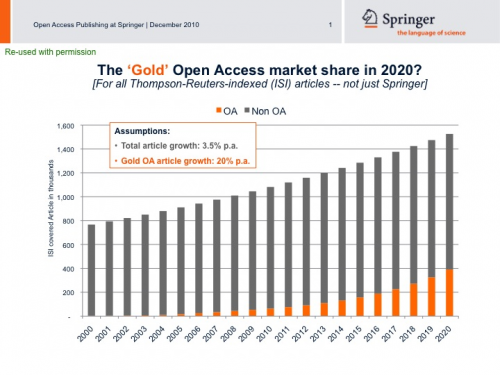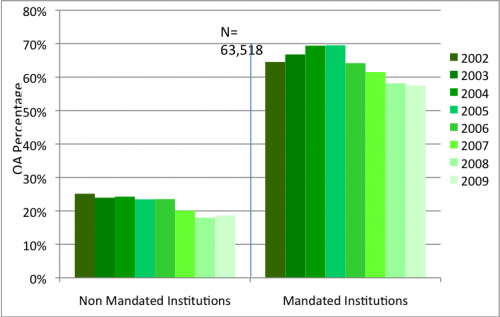 Jan Szczepanski
Jan Szczepanski [
JSZCZ] wrote in the
American Scientist Open Access Forum:
JSZCZ: After collecting free e-journals for more than ten years I'm amazed to read a phrase like this one produced by Steven Harnad.SH: "But gold OA is still premature (whether for journals or books)."
I have concentraded on journals in humanities and social sciences and have more than 12.000 for the moment.
In DOAJ, the directory of open access journals, there are 6.590 titles.
In EZB, Elektronische Zeitschriftenbibliothek, there are more than 32.000 titles.
An astonishing development during these years made by scientists and scholars for scientists for scholars.
The reality is that Steven Harnads opinion is all wrong about journals and also about free e-books. Millions of books are free for all.
This is what I would describe as real open access. Real articles and books.
All OA content -- whether green or gold -- is welcome, valuable and important. That is not the issue. The issue is how to
increase OA content.
To get a realistic idea of how much OA content there is, how fast it is growing, and what scope there is for accelerating its growth, it is not enough simply to count Gold OA items. You have to calculate the annual proportion of Gold OA items, as well as their growth rate, and you have to compare them with the annual proportion and growth rate of Green OA items.
The underlying question is: Which is the surest and fastest way to reach 100% OA, now? And the answer is: by mandating Green OA, not by waiting for Gold OA:
(a) The total annual percentage of journal articles that are OA today averages somewhere between 20% and 30%, and it varies by field.
(b) Out of the overall annual 20-30% OA, according to the 2010 estimates of Bo-Christer Björk for 2009, in the
Thompson-Reuters-ISI-indexed journals the proportion of Green OA was 2/3 and the proportion of Gold OA was 1/3. In non-ISI-indexed journals the relative proportions of the OA subset were reversed (2/3 Gold, 1/3 Green).
(According to
Ulrich's there are about 25,000 peer-reviewed journals across all disciplines today. ISI indexes about the top 20% of them, and about 7% of those 10,000 ISI-indexed journals [but mostly not the top ISI journals] are Gold OA: one wonders what proportion of the 32,000 EZB Gold OA journals -- or of Jan Szczepanski's 12,000 Gold OA humanities and social science journals -- are peer-reviewed journals.)
(c) Out of the overall annual 20-30% OA, according to the 2010 estimates of Bo-Christer Bjork for 2009, in all disciplines except the biomedical ones, the proportion of Green OA was much higher than the proportion of Gold OA. In the biomedical disciplines the relative proportions were reversed. The overall percentage of OA was lowest in the biomedical disciplines.
Björk B-C, Welling P, Laakso M, Majlender P, Hedlund T, et al. (2010) Open Access to the Scientific Journal Literature: Situation 2009. PLOS ONE 5(6): e11273.
(d) In 2010 Springer publishers estimated that for ISI-indexed journals, growth is 3.5% annually and
gold OA growth is 20% (of current Gold OA) annually, so in 10 years the overall percentage of Gold OA will have increased from 8% Gold OA out of all (ISI) articles published in 2010 to 27% Gold OA out of all (ISI) articles published in 2020:
 Figure 1. Projections of Gold OA Growth for ISI-indexed journal articles (data from Springer publishers). Growth will reach 27% of all journal articles by 2020.
Figure 1. Projections of Gold OA Growth for ISI-indexed journal articles (data from Springer publishers). Growth will reach 27% of all journal articles by 2020.
(e) In contrast to the overall annual percentage of OA (20-30%) and Gold OA's growth rate that will take us from its current 8% to 27& in 2020, institutions that mandate Green OA provide over 60% OA, and and keep climbing toward 100% within a few years.

Figure 2. Percent green OA self-archiving averaged for the four institutions with the oldest self-archiving mandates, compared to the percentage for control articles from other institutions published in the same journals (for years 2002-2009, measured in 2011). Mandates triple the percent Green OA. Respective totals are derived from Thompson-Reuters-ISI index.
Gargouri, Y., Hajjem, C., Lariviere, V., Gingras, Y., Brody, T., Carr, L. and Harnad, S. (2010) Self-Selected or Mandated, Open Access Increases Citation Impact for Higher Quality Research PLOS ONE 5 (10)
Hence there are three reasons Gold OA is premature, and (e), above, immediately reveals the first and most important of them:
1. Green OA Can Be Accelerated By Mandating It: Green OA depends only on the research providers -- institutions and funders -- and can hence be accelerated to 100% by mandating it. Gold OA depends upon publishers; institutions and funders cannot mandate it, hence cannot accelerate its growth. (However, mandating Green OA is also likely to accelerate the eventual transition to Gold OA; but first it will provide OA -- 100% OA -- and OA is the primary target and hence the priority of the OA movement.)
2. The Economic Benefits of Green OA Are Greater And More Immediate Than Those of Gold OA: Houghton et al have shown that there are considerable economic benefits to be expected from both Green and Gold OA, but the benefit/cost ratio of Green OA is much higher.
Harnad, S. (2010a) The Immediate Practical Implication of the Houghton Report: Provide Green Open Access Now. Prometheus 28 (1). pp. 55-59.
Houghton, J.W., Rasmussen, B., Sheehan, P.J., Oppenheim, C., Morris, A., Creaser, C., Greenwood, H., Summers, M. and Gourlay, A. (2009). Economic Implications of Alternative Scholarly Publishing Models: Exploring the Costs and Benefits, London and Bristol: The Joint Information Systems Committee (JISC)
3. The Money to Pay for Gold OA Is Still Tied Up In Institutional Journal Subscriptions and the Asking Price For Gold OA Is Still High: The vast majority of journals (and almost all the top journals) are still subscription-based. That means that the potential institutional funds to pay for Gold OA are still tied up in institutional subscriptions, which institutions cannot cancel unless the contents of the journals are accessible to their users by another means. That other means is Green OA -- once it is universally mandated. This is also how Green OA mandates can accelerate the transition to Gold OA. And it is the third reason Gold OA is premature. When distributed Green OA institutional repositories take over the entire function of text-generation, access-provision, and archiving, journals will be able to cut costs by terminating their paper and online editions and providing only the service of peer review, certifying the outcome with the journal name. That means the post-Green-OA cost of Gold OA will then be much lower.
Harnad, S. (2007) The Green Road to Open Access: A Leveraged Transition. In: Anna Gacs. The Culture of Periodicals from the Perspective of the Electronic Age. L'Harmattan. 99-106.
Harnad, S. (2009) The PostGutenberg Open Access Journal. In: Cope, B. & Phillips, A (Eds.) The Future of the Academic Journal. Chandos.
About Gold OA books I have
little to say, except that their proportion (out of all book, or even out of all scholarly/scientific books) is minuscule, cannot be accelerated by mandates, and involves a conflict of interest for royalty-seeking authors -- whereas for journal article authors it does not. Rather the opposite: journal article authors are losing potential usage and impact if only users at subscribing institutions can access their articles.
That -- not absolute Gold OA item counts -- is the reality today.
Stevan Harnad
Enabling Open Scholarship
http://www.openscholarship.org

 Figure 1. Projections of Gold OA Growth for ISI-indexed journal articles (data from Springer publishers). Growth will reach 27% of all journal articles by 2020.
Figure 1. Projections of Gold OA Growth for ISI-indexed journal articles (data from Springer publishers). Growth will reach 27% of all journal articles by 2020.


